Vegetable
"Veggie" redirects here. For the diet which only contains plants, see Veganism. For other uses, see Vegetable (disambiguation).
In everyday usage, a vegetable is any part of a plant that is consumed by humans as food as part of a savory meal. The term vegetable
is somewhat arbitrary, and largely defined through culinary and
cultural tradition. It normally excludes other food derived from plants
such as fruits, nuts, and cereal grains, but includes seeds such as pulses. The original meaning of the word vegetable, still used in biology, was to describe all types of plant, as in the terms "vegetable kingdom" and "vegetable matter".Originally, vegetables were collected from the wild by hunter-gatherers and entered cultivation in several parts of the world, probably during the period 10,000 BC to 7,000 BC, when a new agricultural way of life developed. At first, plants which grew locally would have been cultivated, but as time went on, trade brought exotic crops from elsewhere to add to domestic types. Nowadays, most vegetables are grown all over the world as climate permits, and crops may be cultivated in protected environments in less suitable locations. China is the largest producer of vegetables, and global trade in agricultural products allows consumers to purchase vegetables grown in faraway countries. The scale of production varies from subsistence farmer supplying the needs of their family for food, to agribusinesses with vast acreages of single-product crops. Depending on the type of vegetable concerned, harvesting the crop is followed by grading, storing, processing and marketing.
Vegetables can be eaten either raw or cooked and play an important role in human nutrition, being mostly low in fat and carbohydrates, but high in vitamins, minerals and fiber. Many nutritionists encourage people to consume plenty of fruit and vegetables, five or more portions a day often being recommended.
Etymology
Domestic vegetable garden in the United Kingdom
The meaning of "vegetable" as a "plant grown for food" was not established until the 18th century.[3] In 1767, the word was specifically used to mean a "plant cultivated for food, an edible herb or root". The year 1955 noted the first use of the shortened, slang term "veggie".[4]
As an adjective, the word vegetable is used in scientific and technical contexts with a different and much broader meaning, namely of "related to plants" in general, edible or not — as in vegetable matter, vegetable kingdom, vegetable origin, etc.[2]
Some common vegetables
| Some common vegetables | |||||
|---|---|---|---|---|---|
| Image | Description | Parts used | Origin | Cultivars | World production (×106 tons, 2012)[17] |
 |
cabbage Brassica oleracea |
leaves, axillary buds, stems, flowerheads | Europe | cabbage, red cabbage, Savoy cabbage, kale, Brussels sprouts, kohlrabi, cauliflower, broccoli, Chinese broccoli | 70.1 |
 |
turnip Brassica rapa |
tubers, leaves | Asia | turnip, rutabaga, Chinese cabbage, napa cabbage, bok choy, collard greens | |
 |
radish Raphanus sativus |
roots, leaves, seed pods, seed oil, sprouting | Southeastern Asia | radish, daikon, seedpod varieties | |
 |
carrot Daucus carota |
root tubers | Persia | carrot | 36.9[n 1] |
 |
parsnip Pastinaca sativa |
Root tubers | Eurasia | parsnip | |
 |
beetroot Beta vulgaris |
tubers, leaves | Europe, Near East and India | beetroot, sea beet, Swiss chard, sugar beet | |
 |
lettuce Lactuca sativa |
leaves, stems, seed oil | Egypt | lettuce, celtuce | 24.9 |
 |
beans Phaseolus vulgaris Phaseolus coccineus Phaseolus lunatus |
pods, seeds | Central and South America | green bean, French bean, runner bean, haricot bean, Lima bean | 44.6[n 2] |
 |
broad beans Vicia faba |
pods, seeds | North Africa South and southwest Asia |
broad bean | |
 |
peas Pisum sativum |
pods, seeds, sprouting | Mediterranean and Middle East | pea, snap pea, snow pea, split pea | 28.9[n 2] |
 |
potato Solanum tuberosum |
root tubers | South America | potato | 365.4 |
 |
aubergine/eggplant Solanum melongena |
fruits | South and East Asia | eggplant (aubergine) | 48.4 |
 |
tomato Solanum lycopersicum |
fruits | South America | tomato, see also list of tomato cultivars | 161.8 |
 |
cucumber Cucumis sativus |
fruits | Southern Asia | cucumber, see also list of cucumber varieties | 65.1 |
 |
pumpkin/squash Cucurbita spp. |
fruits, flowers | Mesoamerica | pumpkin, squash, marrow, zucchini (courgette), gourd | 24.6 |
 |
onion Allium cepa |
bulbs, leaves | Asia | onion, spring onion, scallion, shallot, see also list of onion cultivars | 87.2[n 2] |
 |
garlic Allium sativum |
bulbs | Asia | garlic | 24.8 |
 |
leek Allium ampeloprasum |
leaf sheaths | Europe and Middle East | leek, elephant garlic | 21.7 |
 |
pepper Capsicum annuum |
fruits | North and South America | pepper, bell pepper, sweet pepper | 34.5[n 2] |
 |
spinach Spinacia oleracea |
leaves | Central and southwestern Asia | spinach | 21.7 |
 |
yam Dioscorea spp. |
tubers | Tropical Africa | yam | 59.5 |
 |
sweet potato Ipomoea batatas |
tubers, leaves, shoots | Central and South America | sweet potato, see also list of sweet potato cultivars | 108.0 |
 |
cassava Manihot esculenta |
tubers | South America | cassava | 269.1 |
Nutrition and health
Southeast Asian style stir fry ipomoea aquatica in chili and sambal
However, vegetables often also contain toxins and antinutrients which interfere with the absorption of nutrients. These include α-solanine, α-chaconine,[25] enzyme inhibitors (of cholinesterase, protease, amylase, etc.), cyanide and cyanide precursors, oxalic acid and others.[citation needed] These toxins are natural defenses, used to ward off the insects, predators and fungi that might attack the plant. Some beans contain phytohaemagglutinin, and cassava roots contain cyanogenic glycoside as do bamboo shoots. These toxins can be deactivated by adequate cooking. Green potatoes contain glycoalkaloids and should be avoided.[26]
Fruit and vegetables, particularly leafy vegetables, have been implicated in nearly half the gastrointestinal infections caused by norovirus in the United States. These foods are commonly eaten raw and may become contaminated during their preparation by an infected food handler. Hygiene is important when handling foods to be eaten raw, and such products need to be properly cleaned, handled and stored to limit contamination.[27]
Dietary recommendations
The USDA Dietary Guidelines for Americans recommends consuming five to nine servings of fruit and vegetables daily.[28] The total amount consumed will vary according to age and gender, and is determined based upon the standard portion sizes typically consumed, as well as general nutritional content. Potatoes are not included in the count as they are mainly providers of starch. For most vegetables and vegetable juices, one serving is half of a cup and can be eaten raw or cooked. For leafy greens, such as lettuce and spinach, a single serving is typically a full cup.[29] A variety of products should be chosen as no single fruit or vegetable provides all the nutrients needed for health.[21]International dietary guidelines are similar to the ones established by the USDA. Japan, for example, recommends the consumption of five to six servings of vegetables daily.[30] French recommendations provide similar guidelines and set the daily goal at five servings.[31] In India, the daily recommendation for adults is 275 grams (9.7 oz) of vegetables per day.[19]
Cultivation
Further information: Kitchen garden and Vegetable farming
Growing vegetables in South Africa
Different soil types suit different crops, but in general in temperate climates, sandy soils dry out fast but warm up quickly in the spring and are suitable for early crops, while heavy clays retain moisture better and are more suitable for late season crops. The growing season can be lengthened by the use of fleece, cloches, plastic mulch, polytunnels and greenhouses.[32] In hotter regions, the production of vegetables is constrained by the climate, especially the pattern of rainfall, while in temperate zones, it is constrained by the temperature and day length.[33]
Weeding cabbages in Colorado, US
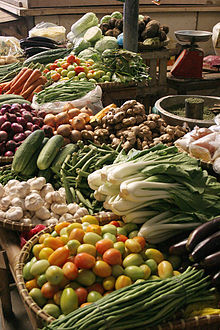

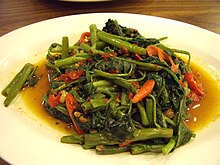
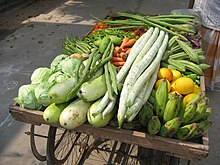
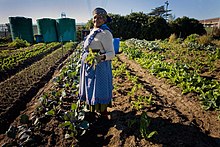
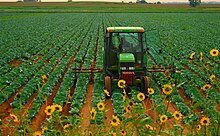
No comments:
Post a Comment